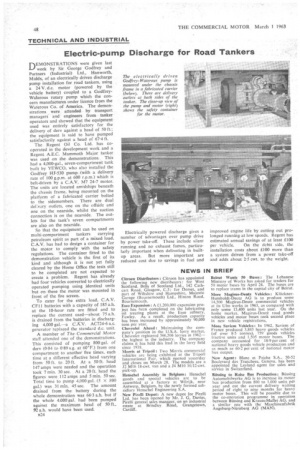Electric-pump Discharge for Road Tankers
Page 50

If you've noticed an error in this article please click here to report it so we can fix it.
DEMONSTRAT1ONS were given last week by Sir George Godfrey and Partners (Industrial) Ltd., Hanworth, MicIdx, of an electrically driven discharge pump installation for road tankers, using a 24 V. d.c. motor (powered by the vehicle battery) coupled to a GodfreyWaterous rotary pump which the concern manufactures under licence from the Waterous Co. of America. The demonstrations were attended by transport managers and engineers from tanker operators and showed that the equipment used was entirely satisfactory for the delivery of dery against a head of 50 ft.; the equipment is said to have pumped satisfactorily against a head of 67-4 ft.
The Regent Oil Co. Ltd. has cooperated in the development work and a Regent A.E.C. Mammoth Major tanker was used on the demonstrations. This had a 4,000-gal., seven-compartment tank built by YEWCO, who also installed the Godfrey HI-530 pump (with a delivery rate of 100 g.p.m. at 600 r.p.m.) which is belt-driven by a C.A.V. M7 24-7 motor. The units are located amidships beneath the chassis frame, being mounted on the platform of a fabricated carrier bolted to the sidemembers. There are dual del:very outlets, one on the offside and one on the nearside, whilst the suction connection is on the nearside. The outlets for the tank's seven compartments are also on the nearside.
So that the equipment can be used on multi-compartment tankers carrying petroleum spirit as part of a mixed load, C.A.V. has had to design a container for the motor to comply with the safety regulations. The container fitted to the demonstration vehicle is the first of its kind and although it is not yet fully cleared by the Home Office the tests still to be completed are not expected to create a problem. Regent has already had four vehicles converted to electrically operated pumping using identical units but on these the motor was mounted in front of the fire screen.
To cater for the extra load, C.A.V. CF11 batteries with a capacity of 185 a.h. at the 10-hour rate are fitted and to replace the current used—about 75 a.h. is drained from the batteries in discharging 4,000 gal.—a C.K.V. AC724-6 ac. generator replaced the standard d.c. unit.
A member of The Commercial Motor staff attended one of the demonstrations. This consisted of pumping 800 gal. of dery (0-84 to 0-89 s.g. at 60°F.) from one compartment to another five times, each time at a different effective head varying from 50 ft. to 20 ft. At a 54) ft. head 147 amps were needed and the operation took 7 mm. 30 sec. At a 20 ft. head the figures were 112 amps and 5 min. 50 sec. Total time to pump 4,000 gal. (5 x 800 gal.) was 31 min. 45 sec. The amount drained from the battery during the whole demonstration was 66-3 al. but if the whole 4.000 gal. had been pumped against the maximum head of 50 ft., 92 al. would have been used.
B24
Electrically powered discharge gives a number of advantages over pump drive by power take-off. These include silent running and no exhaust fumes, partici'. larly important when delivering in builtup areas. But more important are reduced cost due to savings in fuel and
improved engine life by cutting out prolonged running at low speeds. Regent has estimated annual savings of at least £100 per vehicle. On the debit side, the installation costs about £100 more than a system driven from a power take-off and adds about 2-5 cwt. to the weight.
















































































































































